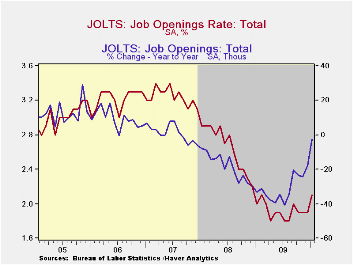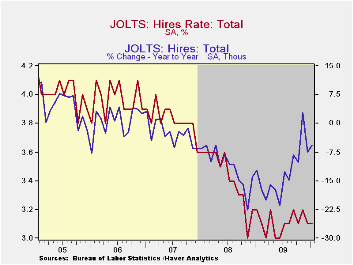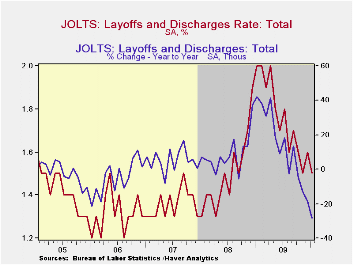 Global| Mar 09 2010
Global| Mar 09 2010JOLTS: U.S. Job Openings Highest Since February '09
by:Tom Moeller
|in:Economy in Brief
Summary
The Bureau of Labor Statistics indicated improvement in January's job market conditions. The latest Job Openings & Labor Turnover Survey (JOLTS) showed that the January job openings rate improved to 2.1% which was the highest level [...]
 The
Bureau
of Labor Statistics indicated improvement in January's job market
conditions. The latest Job Openings & Labor Turnover Survey
(JOLTS) showed that the January job openings rate improved
to 2.1% which was the highest level since last February. The
job openings rate is the number of job openings on the last business
day of the month as a percent of total employment plus job openings. Job
availability doubled its December gain with a 7.6% increase and
remained off just 2.4% year-to-year. The latest figures reflect
benchmark revisions and the series dates back to December
2000.
The
Bureau
of Labor Statistics indicated improvement in January's job market
conditions. The latest Job Openings & Labor Turnover Survey
(JOLTS) showed that the January job openings rate improved
to 2.1% which was the highest level since last February. The
job openings rate is the number of job openings on the last business
day of the month as a percent of total employment plus job openings. Job
availability doubled its December gain with a 7.6% increase and
remained off just 2.4% year-to-year. The latest figures reflect
benchmark revisions and the series dates back to December
2000.
The service sector led the improvement last month. Educational & health service jobs rose 13.2% (-0.5% y/y) and leisure & hospitality jobs increased 11.0% (7.2 y/y). Also, the number of professional & business service openings rose 6.9% (-15.0% y/y. Deterioration in the factory sector reversed the December gain with a 10.5% decline but openings were up by one-third from last year. Construction sector job openings also fell sharply for the third month in the last four +81.8% y/y.
The hires rate has been stable near 3.1% since the end of 2008. The hires rate is the number of hires during the month divided by employment. The actual number of hires reversed half of the December decline with a 2.1% m/m increase (-5.8% y/y). Professional & business service sector hires recouped most of the December decline with a 13.7% increase (+2.1% y/y) while leisure & hospitality hires gained 8.2% (-1.9% y/y). Factory sector hiring increased 3.3% (18.4% y/y) but construction sector hiring fell 2.7% (-8.9% y/y).
The job separations rate was stable at the series' low of 3.2% where it's been since August with the actual number of separations off 19.5% year-to-year. The layoff rate alone fell to a fifteen-month low of 1.5%. Separations include quits, layoffs, discharges, and other separations as well as retirements. The layoff rate alone ticked up to 1.6% but was down sharply from the January high of 1.9%.
The JOLTS survey dates only to December 2000 but has followed the movement in nonfarm payrolls, though the actual correlation between the two series is low
A description of the Jolts survey and the latest release from the U.S. Department of Labor is available here and the figures are available in Haver's USECON database.


| JOLTS (Job Openings & Labor Turnover Survey) | January | December | November | Jan. '09 | 2009 | 2008 | 2007 |
|---|---|---|---|---|---|---|---|
| Job Openings, Total | |||||||
| Rate (%) | 2.1 | 1.9 | 1.9 | 2.0 | 1.9 | 2.2 | 3.1 |
| Total (000s) | 2,724 | 2,531 | 2,456 | 2,792 | 2,531 | 3,078 | 4,378 |
| Hires, Total | |||||||
| Rate (%) | 3.1 | 3.1 | 3.2 | 3.2 | 37.3 | 41.1 | 45.9 |
| Total (000s) | 4,080 | 3,997 | 4,160 | 4,330 | 48,649 | 56,082 | 63,234 |
| Layoffs & Discharges, Total | |||||||
| Rate (%) | 1.5 | 1.6 | 1.5 | 1.7 | 20.7 | 17.7 | 16.5 |
| Total (000s) | 1,890 | 2,049 | 1,973 | 2,641 | 27,683 | 24,589 | 22,606 |
Tom Moeller
AuthorMore in Author Profile »Prior to joining Haver Analytics in 2000, Mr. Moeller worked as the Economist at Chancellor Capital Management from 1985 to 1999. There, he developed comprehensive economic forecasts and interpreted economic data for equity and fixed income portfolio managers. Also at Chancellor, Mr. Moeller worked as an equity analyst and was responsible for researching and rating companies in the economically sensitive automobile and housing industries for investment in Chancellor’s equity portfolio. Prior to joining Chancellor, Mr. Moeller was an Economist at Citibank from 1979 to 1984. He also analyzed pricing behavior in the metals industry for the Council on Wage and Price Stability in Washington, D.C. In 1999, Mr. Moeller received the award for most accurate forecast from the Forecasters' Club of New York. From 1990 to 1992 he was President of the New York Association for Business Economists. Mr. Moeller earned an M.B.A. in Finance from Fordham University, where he graduated in 1987. He holds a Bachelor of Arts in Economics from George Washington University.






